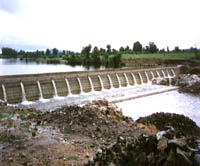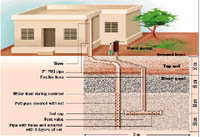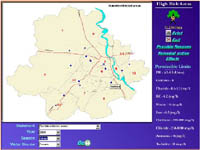|
Catching a Raindrop Dhirendra Kumar Inter-state feuds over water are becoming more and more common in India due to fear of water shortages. Annual water availability per capita in the country, which was earlier 5,000 cubic meters, has dropped to 2,200 cubic meters. This is against the world figure of 8,500 cubic meters. Therefore, India is fast approaching a phase of extremely stressed water availability conditions. Several perennial flows like the Ganga-Brahmaputra are becoming seasonal. Rivers are dying or declining and aquifers are getting over-pumped. Thus, people have to depend on limited municipal water supply. Consequently, they are forced to rely on their own resources. This scarcity has lead to the birth of water markets, with private entrepreneurs doing business in supplying water tankers. This, once again, is putting pressure on surface and groundwater sources, which are fast depleting all over the country.
But, every crisis spurs its own solution. Since rain and snow precipitation are the only original sources of water on land, there needs to be a sustained drive for managing rainwater and its run-off. India receives the highest rainfall among countries comparable to its size. But the rainfall’s temporal and spatial distribution is uneven. Most of the rainfall is concentrated in just a few months of the year – 70 percent rainfall occurs in four months. So, even in a year of normal rainfall, some parts face severe drought. There is, therefore, need to harvest rainwater and the harvested rainwater can be used for direct consumption or for recharging groundwater through simple filtration devices. Looking back to look forward… The concept of rainwater harvesting is an age old one, but systematic collection and recharging of groundwater is a practice of recent times. Indians learnt this water arithmetic as far back as 5,000 years. The city of Dholavira of the Indus Valley Civilisation was harvesting rainwater even in the dry Thar desert.
Regulatory and Social Obligations Section Five of the Environment (Protection) Act, 1986, makes it mandatory for those who are using tubewell water to equip themselves with rainwater harvesting systems. For those using water supplied by public health departments, it becomes their social responsibility to contribute to the recharging of underground reservoir of the region, which in most cases is depleting steeply year after year. Mindful of the threats, some state governments are enacting legislation to make rainwater harvesting compulsory in all housing societies, residential, commercial, and industrial and other complexes. The Delhi Development Authority and the Municipal Corporation of Delhi have made amendments in existing building by-laws, making it compulsory for every house or hotel, occupying an area of 200 yards or more, to undertake rainwater harvesting. Water harvesting is not for urban community alone – it needs to be harvested by all, even in rural and industrial settings. How to Harvest Rainwater Broadly, rainwater can be harvested for two purposes:
Storage of rain water during scarcity For harvesting roof top rainwater, storage tanks may be required. These tanks may be constructed on the surface as well as underground by utilising local materials. The size of a tank depends upon the availability of runoff and water demand. Some maintenance measures like cleaning and disinfection are required to ensure the quality of water stored in the container. Recharging of ground aquifers Alternative to storing, rainwater may be charged into the groundwater aquifers. This could be done through suitable structures like dugwells, borewells, recharge trenches and recharge pits. How much water could be harvested? The amount of water harvested depends on:
How much runoff occurs
Water harvesting potential = Catchment area (Sq. m.) X Collection efficiency X Rainfall (mm) The collection efficiency accounts for the fact that all the rainwater falling over an area cannot be effectively harvested, because of evaporation, spillage etc. General values are tabulated below which are generally used for assessing the potential.
The following is an illustrative theoretical calculation that highlights the enormous potential for rainwater harvesting: In Delhi, average rainfall is 611 mm. A catchment area of 100 sq.m. with collection efficiency of 80% can yield 48,880 litres of water per annum. Design considerations Three most important components, which need to be evaluated for designing the rainwater harvesting structures, are:
Components of rainwater harvesting systems A typical rainwater harvesting system comprises – a) catchment b) gutters c) pipes d) Rainwater / storm water drains e) filter mechanism f) storage tanks or ground water recharge structures like pit, trench, tube well or combination of the above structures. Cost The cost depends on the volume of water to be harvested. The harvesting structure’s cost for a building (spread over 4 to 5 acres) that has 80 to 90 apartments, will be about Rs. 40,000. For a bigger plot which houses a bigger office complex or upto 150 apartments, the expense could be about Rs. 80,000. Almost equal components of this cost are – drilling expenses, brick work and filter mechanism. Operational Control Just constructing rainwater harvesting structures is not the ultimate solution. To prevent the pollutants entering into the ground or the storage tanks and to harness the maximum benefits, we must:
Precautions Before giving the design of the proposed structures, one should look into the following essentials. Overlooking them may reduce the benefits:
Future Ahead......... Rain is decentralised. So is the demand for water. Rainwater harvesting is an ideal solution to solve the water crisis. It is high time that individuals took the initiative and shifted towards this more comprehensive and decentralised way of catching raindrops and augmenting water availability. CLEAN-India too has initiated water harvesting systems in schools and communities. In conclusion the message of the hour is: "Catch every drop of rain where it falls." q
|



